
I love massing one kind of echeveria in pots and letting them multiply like crazy. Echeveria lilacina has completely filled in at the base of the shaving brush tree, Pseudobombax ellipticum. One E. liliacina in bloom is a novelty; over a dozen in bloom is an event.

I instagrammed the blooming echeveria and was asked about the tree. Which got me wondering about the age of the shaving brush tree, which led me to this post “Back on the Home Front” in July 2014. (The tree bloomed this year, an event also noted on Instagram.) I’m still unsure about the exact age of the tree, now with an over 8-foot trunk, but the earliest entry I could find was 2014. Looking at the rest of the post, July 2014 struck me as a fairly ambitious month in the garden, a time when I was working on more color for summer, whereas the 2019 garden has grown shrubbier, with more aloes and agaves grown among sesleria and horned poppies/glaucium. And since I often feel that followup on all the plants I talk about over the years can be somewhat inconsistent, it seemed like a good opportunity to revisit some of the plants grown in July 2014. Where are they now?

“Really brightens things up. Corokia virgata ‘Sunsplash'”
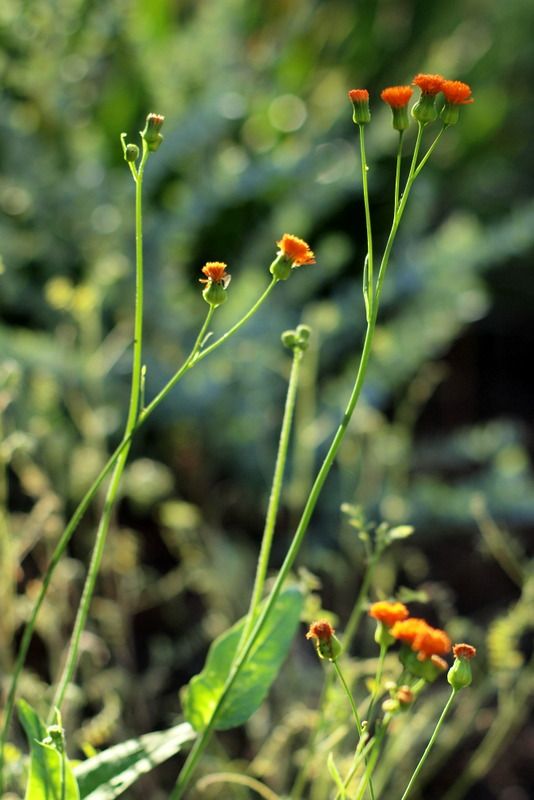
“Emilia may be small, but it packs a big orange punch in its ‘Irish Poet’ form”
Looking at the July 2014 post, this is a partial list of the plants no longer in the garden July 2019. Others are discussed under their photos. Not a comprehensive discussion, just some highlights:
- Musschia wollastonii is monocarpic, one and done. A really fun plant to grow, but needs a big pot and consistent moisture to bring to bloom.
- Emilia javanica ‘Irish Poet’ reseeded for a few years and I’d love to bring this tassel-headed charmer back to the garden. Takes up no space and doesn’t mind it on the dry side.
- Cussonia gamtoosensis was fabulous while it lasted. It grew into a sizable 12-foot tree sandwiched between the bocconia and Grevillea ‘Moonlight’ but became increasingly destabilized and lost root purchase, lurched forward and had to be removed. I’d grow another one in a pot in a heartbeat if I could find it. I really feel it’s the most beautiful of the cabbage trees. Remaining potted cussonias include spicata, paniculata, and natalensis.
- Corokia virgata ‘Sunsplash‘ is another great plant currently not in the garden. A bright light in the dry garden, great in pots or in the ground. Always welcome here.
- Pennisetum ‘Sky Rocket’ — boy, do I cycle through the grasses, but it wouldn’t be summer without them. Individual drawbacks are chiefly the speed of growth and quickness to girth. ‘Sky Rocket,’ a sterile selection, was too much for a small, crowded garden, but it’s a stellar grass all the same and made a big impact in one year’s growth, unlike the summer 2019 class (Miscanthus transmorrisonensis, Miscanthus ‘Silver Sceptre’) — I miss the oaty, arching plumes of pennisetums, but they do require a strong back to maintain them.
- Gomphrena ‘Fireworks’ is perennial here and does reseed but was crowded out and didn’t make a reappearance this summer. I like it but decided not to bring in new plants this year. The effect is like having alliums all summer but in a shrubby form. Self-sown nicotianas took up a lot of their real estate.
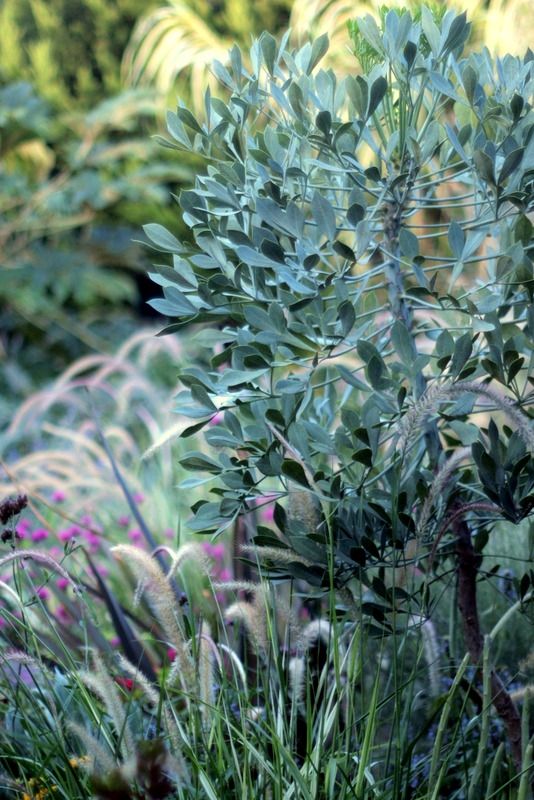
“The plumes arch just where the Cussonia gamtoosensis canopy begins, a wonderful effect that’s unlikely to be duplicated next year as the cabbage tree continues to grow. Today I watched for the first time as a sparrow landed in the baby cussonia, which to my mind makes it a real tree now.”
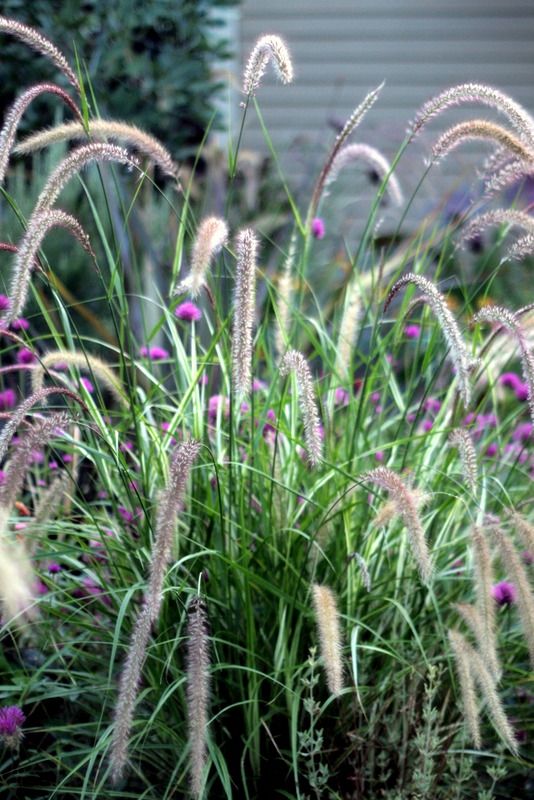
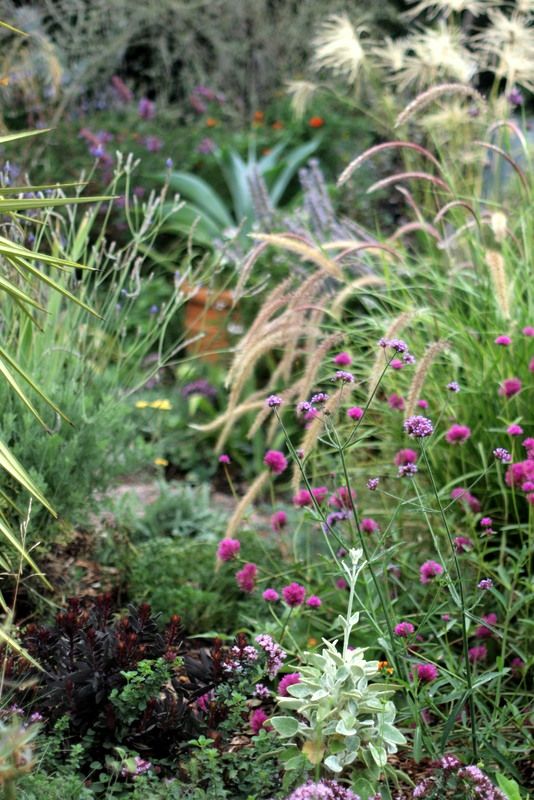
“Marigolds in the distance, the new Leucadendron ‘Ebony’ in the foreground, handling its first summer beautifully so far. The sideritis to its right wasn’t so lucky, inexplicably collapsing a couple days ago, about a day after this photo was taken. Every so often around mid-summer, this mysterious soil-borne wilt process takes out a plant. I know in my absence the garden was watered really well for a change, and that might have kicked it off. The sideritis was one of two self-sown seedlings I found this spring, so it was a gimme anyway. I’ve already planted a couple Cirsium occidentale in its place. ”
I’m pretty sure I’m on my second Leucadendron ‘Ebony’ since 2014. And the sideritis proved to be a little touchy in the amended clay of the back garden. I haven’t brought any more in recently since they do tend to collapse, but I did find a seedling in a graveled area the other day. (A good silver has unexpectedly turned out to be the dwarf selection of a native buckwheat, Eriogonum giganteum var. compactum, now blooming in its second year.) As far as replacing the sideritis with some Cobweb Thistle in 2014, coincidentally, I recently planted a couple Cirsium occidentale in the front gravel garden, where they’ll get much better air movement and leaner soil. What a merry-go-round.

“What an undeserving bad rap the bedding plants industry has given marigolds. The tall strains like this one, ‘Cinnabar’ from Derry Watkins, are so hot. If you don’t have a bias against orange, that is.”
I haven’t grown the tall strains of marigolds much either. I’ve been avoiding planting annuals in the garden itself, which increases the need for supplemental irrigation, and mostly confine annuals and bulbs to pots. But there’s no reason I couldn’t grow these marigolds in containers too, so maybe next summer…I’ve taken a break from trialing agastaches too. There just isn’t enough elbow room and air flow now.
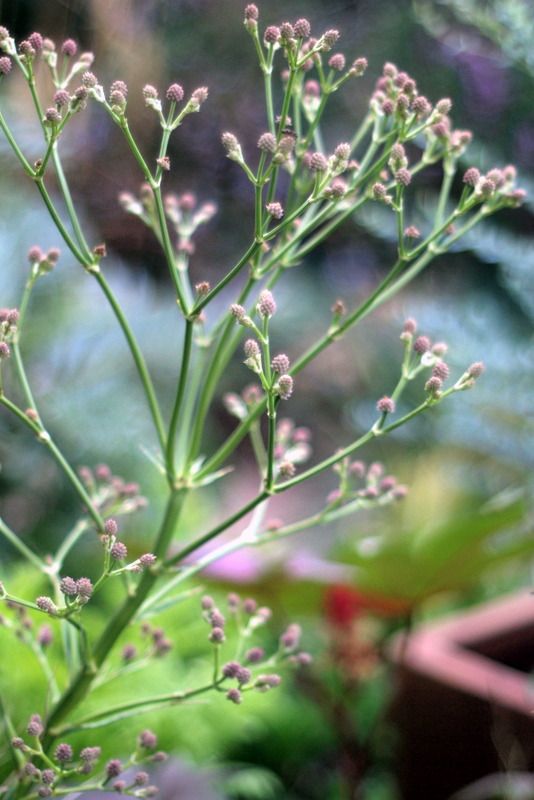
“Eryngium pandanifolium in its second year, reliably blooming again, a great relief.”

There’s the eryngium way in the back, throwing its two bloom stalks this year. The bocconia has crowded out 2014’s Gomphrena ‘Fireworks’ and self-sown nicotiana are better suited to the increasing shade under the bocconia. On the left, as tall as the 6-foot-plus hedge, that’s the second Adenanthos sericeus in the garden. The coastal woolybush growing in 2014 died.
In its second year in 2014, this eryngium was still situated close to the pergola, the serrated leaves scratching our feet. The current plant is a seedling from the one grown in 2014, and the blooms strike me as smaller and paler. The leafy growth is substantial and makes an enormous clump at least 4 feet across, and even now that it’s an unquestionably mature plant in 2019, it only throws a couple of bloom stalks, which may be why it isn’t more frequently seen or talked about. It might be a more prolific bloomer in wetter conditions. I doubt I’d get anything else established in that dry, root-infested strip near the back wall, so it stays. I’ve kind of bonded with it but can’t unreservedly recommend it for small gardens. Both those lilies, btw, were mislabeled. One was supposedly the trumpet ‘African Queen’ and the other a dark red — which turned out to be white. I prefer intense, saturated colors for summer bulbs and annuals, but at least these lilies have that incredible scent.

“Aristolochia fimbriata scoffs at any neglect I throw its way. No surprise that it was included on the sales tables at a recent succulent show. It’s that tough.”
This little aristolochia is still defying the odds in a crowded garden and returning every year. I keep meaning to pot it up and give it some love — because I bet it transforms from an interesting survivor into a thing of beauty.
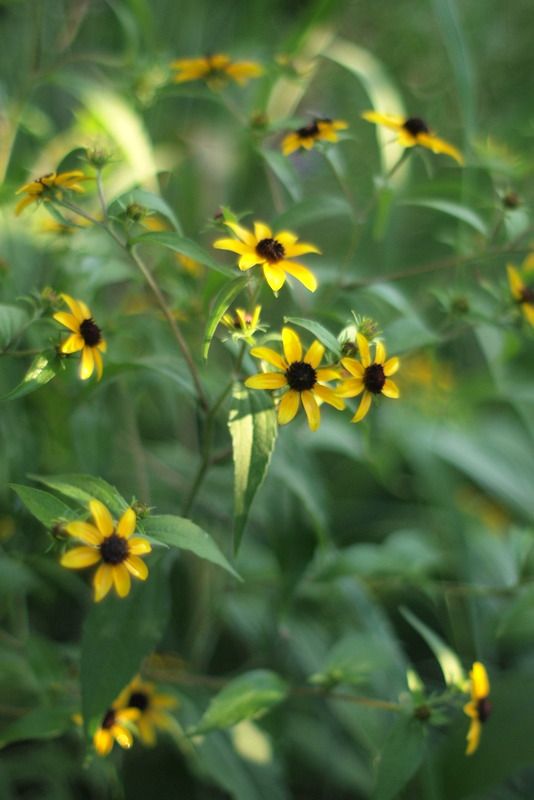
I had high hopes for Rudbeckia triloba, but it needed much more frequent irrigation.
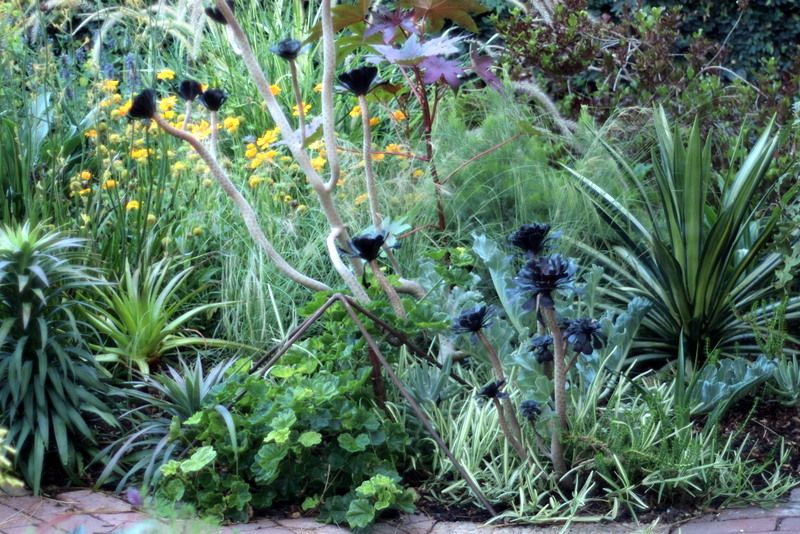
“The front of the cussonia border, which shows how Aeonium ‘Zwartkop’ looks in its summer dormancy period here. I can appreciate ‘Zwartkop’s’ skeletal form, as opposed to the giant ‘Cyclops,’ which was getting increasingly annoying in its off-season shabbiness, so it’s been pulled out of the garden to be grown in a container. All the plants here are well adapted to low water use, except for a couple patrinia I foolishly included this year. Crambe maritima is doing really well, another plant I saw in several Portland gardens recently. Yucca, furcraea, gaillardia, adenanthos, coprosma, Pelargonium ‘Crocodile,’ anigozanthos, agastache, echium, Rekohu carex. A Beschorneria alba is in here somewhere too. Variegated St. Augustine grass is weaving through the legs of the aeonium and spilling onto the bricks.”
All this ground level busy-ness has shifted to an emphasis on height and bulk, seen below, from bocconia and Grevillea ‘Moonlight’. No longer in the garden, the ‘Crocodile’ pelargonium with the gold-fretted leaves is always worth growing but hard to find. Yucca ‘Blue Boy’ on the left has expanded into a colony. The kangaroo paws still bloom every year (!!) The aeonium has been moved elsewhere, and that Variegated Hemp Agave (Agave sisalana forma medio-picta) is now in Mitch’s garden. The Crambe maritima made sprawling leafy growth and never bloomed, which isn’t such a bad bargain but I’ve always wanted to see those incredible nubby seedheads, and it just wasn’t going to happen here. The increasing shade became problematic too. The castor bean ‘New Zealand Purple’ still reseeds, with the seedlings moved to more sun. The variegated St. Augustine’s grass has been moved under the fernleaf acacia. Basically, this sunny patch has been transformed into the shady understory of Grevillea ‘Moonlight.’ Agaves ‘Mateo’ and ‘Snow Glow’ don’t seem to mind the filtered sun, but I may move ‘Snow Glow’ in fall. Bilbergia ‘Hallelujah’ thrives here too.

In the graveled area under the metal stand grow succulents, mangaves, with Carex testacea reseeding throughout, an effect I enthusiastically endorse.
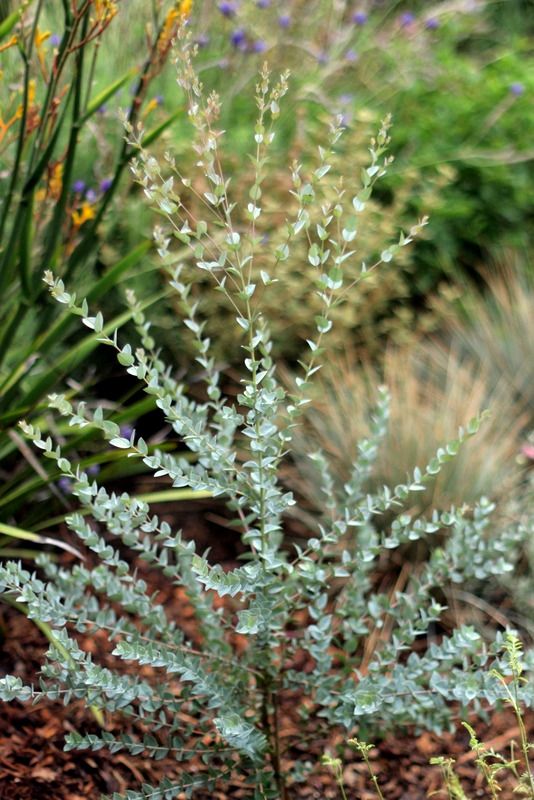
“A large mint bush near the ‘Cyclops’ aeonium was showing its age, so that was given the heave-ho recently too. Prostranthera never gets older than a few years in my garden and is well known to be short-lived. Waiting in the wings, outgrowing its pot was Eucalyptus ‘Moon Lagoon,’ which I intended on planting in the mint bush’s spot in the fall. This is one of the mallee eucalyptus, which are more large shrubs than the towering giants Californians associate with eucalyptus.”
What can I say? I knew the mint bushes were short-lived (prostanthera), but I expected more longevity from Eucalyptus ‘Moon Lagoon.’ What a beauty while it lasted.
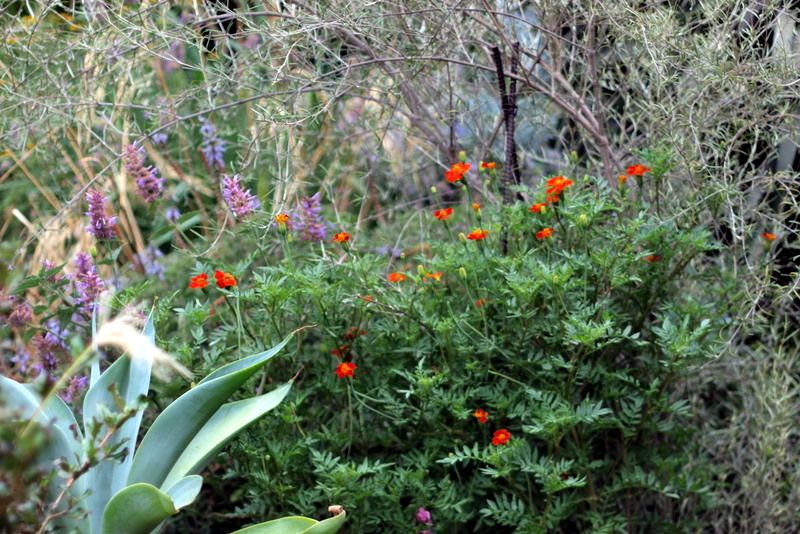
“The grey shrub arching over the marigolds is Olearia virgata v. lineata ‘Dartonii,’ brought home from Far Reaches Farm a few years ago. (“If you’ve hankered for a willow but lament your dry conditions, then weep no more.”) It was so cool to see this shrub growing against the greenhouse at Old Germantown Gardens in Portland recently, where it was tightly clipped in a more columnar form. The Agave attenuata is ‘Boutin’s Blue,’ formerly ‘Huntington’s Blue,’ not quite happy in full sun. In a large pot, it’s the Goldilocks of agaves and gets moved around quite a bit.”
Agave ‘Boutin’s Blue’ is now much happier in the shady front garden, growing under the triangle palm with Fatsia ‘Spider Web.’ The olearia is an interesting shrub for larger gardens maybe, but was sprawly and whippy here, requiring increasingly more pruning so was ultimately pulled.
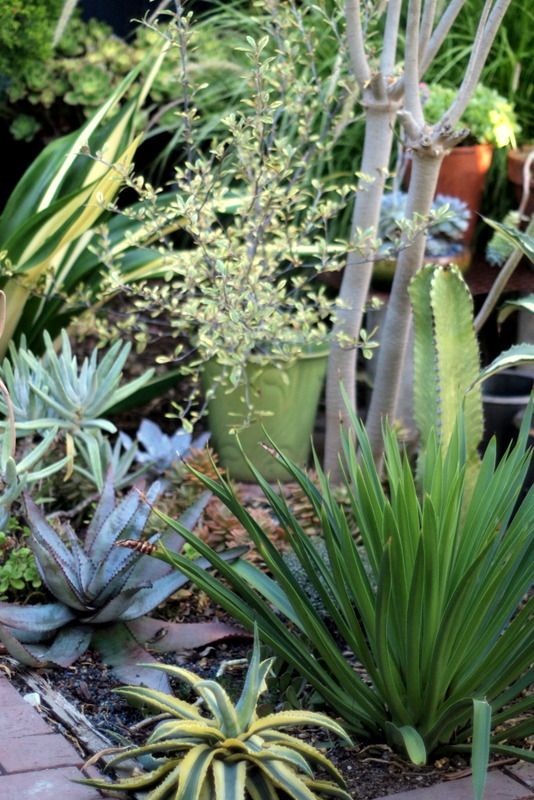
“That golden-leaved shrub thrives in pot culture, even the careless kind I practice.”
(wiry New Zealander Corokia virgata ‘Sunsplash’)
Scale really love to throttle beschorneria in my garden, and this beautiful clump was killed off by them after blooming. Agave ‘Cornelius’ has been moved to a pot. I think the trunks probably belong to Euphorbia lambii, which is a terrible reseeder here, but still I miss having a big specimen around. This Aloe capitata x quartzicola either died or was moved. The current one is much happier in full sun. The Euphorbia ammak is growing in a pot in full sun, over 6 feet tall now. The furcraea became increasingly shaded by the lemon cypresses and remorseless scale moved in, so it was removed.

The little strip currently is occupied by small succulents, bromeliads, Aloe wickensii, with the trailing jade Senecio jacobensii nicely performing ground cover duties. The potted tree aloe ‘Goliath’ has recovered from a bout of mites but is constantly under attack from aphids in the tight interstices between leaves. Frequent Safer’s soap spraying prevents severe infestations.

Pink trumpets belong to Sinningia ‘Invasion Force’ dangling over Beschorneria ‘Flamingo Glow,’ planted a few days ago. Newest member of the class of July 2019! And I’d love to try some argemone species from seed for next summer’s class of 2020…

I really enjoyed this retrospective Denise and it was quite affirming to those of us that trial, toss (or kill) and then replant –and the cycle continues. I remember you telling me in Denver about the sudden and unexpected demise of E. ‘Moon Lagoon’ . These endless transformations and botanical experiments are really the lifeblood of engagement in our gardens if you ask me.
I always admire that Eryngium pandifolium when I see it in your blog. Your Grevillea ‘Moonlight’ never ceases to impress me too – mine gave up and died but I’m committed to trying it again in some other portion of my garden when the right spot opens up.
I’m afraid to take a close look at all the plants I loved and lost. I’m terrible at updating my record when a plant dies or I become frustrated and pull one out. I cross out plants I know are gone on a haphazard basis when I have occasion to check the list. Still, there are a LOT of plants with lines drawn through their names! Losses don’t always prevent me from (consciously or not) putting in the same plant again, however.
Interesting to see how your garden is evolving and changing. I have become more philosophic about plant losses looking at any loss as an opportunity to cram something new in.
What an adventure! Your garden is like a travel show.
‘Moon Lagoon’ is alive and well here. This past wet winter, the rain drops hung on all over it, it like the crystals of a chandelier, sparkling.
This is just an excellent post format, and reflects a phenomenon I think the majority of seasoned gardeners do in their head. I love poring over a decades-worth of photographs of a particular spot, cracking open an old plant inventory, and musing about where shit it went (or didn’t). This works particularly well with your garden, which always seems to get better and more refined.
Are you going to make this a (semi?)regular feature? I’d love to see others adopt it, a la Bloomday.